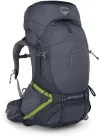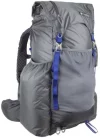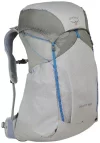Iuri Colares
New Member
- Time of past OR future Camino
- Camino Frances (September 23, 2018)
Which of the following backpacking packs would you recommend for Camino Frances from late September through October?
Source: https://www.switchbacktravel.com/best-backpacking-backpacks
1. Osprey Atmos AG [50]

Weight: [4 lbs.]
Fabric: Nylon (100D x 630D)
Capacity: [50L]
What we like: Close fit and fantastic back ventilation.
What we don’t: No zipper to the main compartment.
The Atmos AG is our top backpacking pack for 2018 by deftly balancing all of our priorities: comfort, organization, durability, and weight. The attention grabber is the suspended “Anti-Gravity” backpanel, but we like the Atmos because it’s a lot more than just an advancement in pack ventilation. We’ve found it easy to dial in a good fit, the pocket design is thoughtfully laid out (although we’d prefer zippered access to the main compartment), and it’s tough enough for rough treatment while staying under 5 pounds. Overall, the Atmos is an extremely well rounded design that works great for anything from quick overnight trips to extended jaunts into the backcountry.
As mentioned above, the most prominent feature on the Atmos AG is its mesh backpanel. Bucking the trend of protruding foam panels that contact your back in certain areas—back, lumbar, and hips—the Atmos AG has a single large ventilated panel that covers the entire back and hipbelt. The result is best-in-class ventilation, and the flexible mesh conforms to your back and waist very well. Impressively, the design manages to carry heavy gear comfortably—we’ve had it loaded with over 45 pounds on more than one occasion—although the mesh is a little less supportive than the foam on a pack like the Gregory Baltoro below. Those looking to shave weight certainly can do so with one of ultralight choices below, but it’s tough to beat the feature set and build quality of the Atmos AG...
2. Gossamer Gear Mariposa 60

Weight: 2 lbs. 0.7 oz.
Fabric: Nylon (100D & 200D)
Capacity: 60L
What we like: Impressive durability, capacity, and comfort for the weight.
What we don’t: Foam backpanel bunches up.
A number of ultralight packs are designed for thru-hikers and minimalists, but our top pick is the Gossamer Gear Mariposa 60. Most impressive is how few tradeoffs there are in using this 2-pound 3-ounce bag (ours has a large frame and medium hipbelt). While brands like Hyperlite and Zpacks use Dyneema fabric (formerly cuben fiber) to cut weight, Gossamer Gear uses a light yet tough Robic nylon. Unlike our Dyneema packs, we’ve had no issues with punctures or wear from the Mariposa. It’s still smart to take extra care when bushwhacking or setting the pack down on rocks, but so far it’s the least compromised ultralight pack we’ve tested.
Organization on the Mariposa is excellent. In addition to the large main compartment, the pack has a total of 7 external pockets of varying sizes, making it easy to distribute your gear. Comfort-wise, we’ve found the Mariposa has sufficient padding and plenty of support right up to its 35-pound maximum rating. If we were to change one thing, it would be the backpanel: the removable foam padding is prone to bunching and we prefer to leave it behind. Otherwise, the Mariposa stands out as the most complete ultralight pack on the market and a great option for backpackers looking to cut weight...
3. Osprey Levity [45]

Weight: 1 pound 12 oz.
Fabric: Nylon (210D x 200D & 30D)
Capacity: [45L]
What we like: Super light without being overly compromised.
What we don’t: Can’t carry more than 30 pounds comfortably.
Osprey’s Exos has been their leading ultralight pack model for years, but the all-new, sub-2-pound men's Levity and women's Lumina is on a whole new level. We recently took the 60-liter model to Utah’s Canyon Country and it quickly stood out. Despite weighing 12 ounces less than the Exos, the Levity never felt delicate or compromised. You get a real metal frame that provides a solid structure, excellent ventilation with the suspended mesh backpanel, and the 210 x 200-denier nylon covering a good portion of the pack was plenty durable when brushing up against red rock. All told, we were so impressed with the Levity that’s its already overtaken the Exos on our list for 2018.
What are the shortcomings of the Osprey Levity 60? We carried a little under 30 pounds on our trip and were comfortable, but it was clear that the thin padding along the shoulder straps and hipbelt couldn’t handle much more weight. Further, the pack body and sides of the lid use a 30-denier silnylon, which is so thin that it’s see-through (we haven’t put any holes in it, however). But the Levity’s combination of functional organization, excellent build quality, and low weight quickly should make it a top choice among thru-hikers and other ultralight backcountry adventurers...
Source: https://www.switchbacktravel.com/best-backpacking-backpacks
1. Osprey Atmos AG [50]

Weight: [4 lbs.]
Fabric: Nylon (100D x 630D)
Capacity: [50L]
What we like: Close fit and fantastic back ventilation.
What we don’t: No zipper to the main compartment.
The Atmos AG is our top backpacking pack for 2018 by deftly balancing all of our priorities: comfort, organization, durability, and weight. The attention grabber is the suspended “Anti-Gravity” backpanel, but we like the Atmos because it’s a lot more than just an advancement in pack ventilation. We’ve found it easy to dial in a good fit, the pocket design is thoughtfully laid out (although we’d prefer zippered access to the main compartment), and it’s tough enough for rough treatment while staying under 5 pounds. Overall, the Atmos is an extremely well rounded design that works great for anything from quick overnight trips to extended jaunts into the backcountry.
As mentioned above, the most prominent feature on the Atmos AG is its mesh backpanel. Bucking the trend of protruding foam panels that contact your back in certain areas—back, lumbar, and hips—the Atmos AG has a single large ventilated panel that covers the entire back and hipbelt. The result is best-in-class ventilation, and the flexible mesh conforms to your back and waist very well. Impressively, the design manages to carry heavy gear comfortably—we’ve had it loaded with over 45 pounds on more than one occasion—although the mesh is a little less supportive than the foam on a pack like the Gregory Baltoro below. Those looking to shave weight certainly can do so with one of ultralight choices below, but it’s tough to beat the feature set and build quality of the Atmos AG...
2. Gossamer Gear Mariposa 60

Weight: 2 lbs. 0.7 oz.
Fabric: Nylon (100D & 200D)
Capacity: 60L
What we like: Impressive durability, capacity, and comfort for the weight.
What we don’t: Foam backpanel bunches up.
A number of ultralight packs are designed for thru-hikers and minimalists, but our top pick is the Gossamer Gear Mariposa 60. Most impressive is how few tradeoffs there are in using this 2-pound 3-ounce bag (ours has a large frame and medium hipbelt). While brands like Hyperlite and Zpacks use Dyneema fabric (formerly cuben fiber) to cut weight, Gossamer Gear uses a light yet tough Robic nylon. Unlike our Dyneema packs, we’ve had no issues with punctures or wear from the Mariposa. It’s still smart to take extra care when bushwhacking or setting the pack down on rocks, but so far it’s the least compromised ultralight pack we’ve tested.
Organization on the Mariposa is excellent. In addition to the large main compartment, the pack has a total of 7 external pockets of varying sizes, making it easy to distribute your gear. Comfort-wise, we’ve found the Mariposa has sufficient padding and plenty of support right up to its 35-pound maximum rating. If we were to change one thing, it would be the backpanel: the removable foam padding is prone to bunching and we prefer to leave it behind. Otherwise, the Mariposa stands out as the most complete ultralight pack on the market and a great option for backpackers looking to cut weight...
3. Osprey Levity [45]

Weight: 1 pound 12 oz.
Fabric: Nylon (210D x 200D & 30D)
Capacity: [45L]
What we like: Super light without being overly compromised.
What we don’t: Can’t carry more than 30 pounds comfortably.
Osprey’s Exos has been their leading ultralight pack model for years, but the all-new, sub-2-pound men's Levity and women's Lumina is on a whole new level. We recently took the 60-liter model to Utah’s Canyon Country and it quickly stood out. Despite weighing 12 ounces less than the Exos, the Levity never felt delicate or compromised. You get a real metal frame that provides a solid structure, excellent ventilation with the suspended mesh backpanel, and the 210 x 200-denier nylon covering a good portion of the pack was plenty durable when brushing up against red rock. All told, we were so impressed with the Levity that’s its already overtaken the Exos on our list for 2018.
What are the shortcomings of the Osprey Levity 60? We carried a little under 30 pounds on our trip and were comfortable, but it was clear that the thin padding along the shoulder straps and hipbelt couldn’t handle much more weight. Further, the pack body and sides of the lid use a 30-denier silnylon, which is so thin that it’s see-through (we haven’t put any holes in it, however). But the Levity’s combination of functional organization, excellent build quality, and low weight quickly should make it a top choice among thru-hikers and other ultralight backcountry adventurers...






















